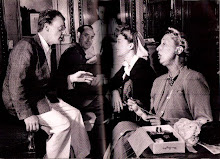
 I just recently watched the 1942 James Cagney movie Yankee Doodle Dandy, and it was quite fun. James Cagney was bravura as George M. Cohan, the famous patriotic song-and-dance man who gave us such songs as "Yankee Doodle Boy" and "You're a Grand Old Flag." Cagney won his only Oscar™ for Best Actor for this role (and I'm proud of him). One of my favorite songs in this film is "Harrigan" but only because of the way Cagney sings it—with an Irish brogue. I love it when he uses an Irish accent!
I just recently watched the 1942 James Cagney movie Yankee Doodle Dandy, and it was quite fun. James Cagney was bravura as George M. Cohan, the famous patriotic song-and-dance man who gave us such songs as "Yankee Doodle Boy" and "You're a Grand Old Flag." Cagney won his only Oscar™ for Best Actor for this role (and I'm proud of him). One of my favorite songs in this film is "Harrigan" but only because of the way Cagney sings it—with an Irish brogue. I love it when he uses an Irish accent!
 Although he now seems the only logical choice, Cagney would have missed out on his big chance if a deal between Cohan and MGM to make a film to be called The Four Cohans hadn't fizzled out. Covering the years when Cohan had toured with his father, mother and sister, the movie would have starred Mickey Rooney as the young Cohan. The deal collapsed after studio head Louis B. Mayer refused to allow Cohan the right to final cut on the proposed film. The next movie mogul to show an interest in the project was Samuel Goldwyn, who had a commitment to make a film starring Fred Astaire. When Astaire refused the role of Cohan as not right for him, the rights were picked up by Warner Bros., who cast resident star Cagney in the role with Cohan's blessings. (And it's a good thing too! Can u imagine Mickey Rooney or Fred Astaire playing George M. Cohan?) Cagney, in particular, was eager to play Cohan because he was, at the time, suspected of being a communist sympathizer due to his union activities (he was president of the Screen Actors' Guild) and because of his open support of the New Deal. He wanted to show his patriotism on screen, and the George M. Cohan story was the perfect vehicle to do this.
Although he now seems the only logical choice, Cagney would have missed out on his big chance if a deal between Cohan and MGM to make a film to be called The Four Cohans hadn't fizzled out. Covering the years when Cohan had toured with his father, mother and sister, the movie would have starred Mickey Rooney as the young Cohan. The deal collapsed after studio head Louis B. Mayer refused to allow Cohan the right to final cut on the proposed film. The next movie mogul to show an interest in the project was Samuel Goldwyn, who had a commitment to make a film starring Fred Astaire. When Astaire refused the role of Cohan as not right for him, the rights were picked up by Warner Bros., who cast resident star Cagney in the role with Cohan's blessings. (And it's a good thing too! Can u imagine Mickey Rooney or Fred Astaire playing George M. Cohan?) Cagney, in particular, was eager to play Cohan because he was, at the time, suspected of being a communist sympathizer due to his union activities (he was president of the Screen Actors' Guild) and because of his open support of the New Deal. He wanted to show his patriotism on screen, and the George M. Cohan story was the perfect vehicle to do this.

Yankee Doodle Dandy, with its many flag-waving musical numbers, proved just the ticket for World War II-era audiences and became the top-grossing movie of its year, as well as Warners' top-grossing movie to that time. It was nominated for Academy Awards in eight categories, including Best Picture and Director (Curtiz), and won three Oscars, including one for Cagney as Best Actor. I also find it amazing that Joan Leslie, who played Cohan's wife Mary, was younger than me when she made this film (she was 17).


The problem with biopics is that they are often fictionalized for dramatic effect (Hollywood is very notorious for these sorts of things), and this one is no exception! I could hardly tell what was fact and what was fiction when watching this movie. Let that be a lesson: Never attribute anything you've learned to a Hollywood movie or TV show. (I think I'm being a bit hypocritical when I say that because I usually attribute everything I've learned to The Simpsons or Family Guy, which are not the most reliable sources for information .)


One of Curtiz' keys to success was the decision to allow Cagney free rein in his scenes, permitting the actor to improvise as the cameras were rolling. A prime example, and reportedly Cagney's favorite moment in the film, is when he suddenly breaks into a tap-dance as he comes down the stairs in a scene at the White House where Cohan has met with President Franklin Roosevelt. The ordinarily hard-boiled Curtiz was so moved by the scene in which Cohan bids farewell to his dying father (Walter Huston) that he reportedly ruined a take with his loud sobs. (I didn't really cry at that scene, which surprised me, but I've cried at scenes that were more emotionally powerful, like one scene in a Shirley Temple film.)
 Walter Huston was especially great in this film; he would later be in the Humphrey Bogart film Treasure of the Sierra Madre (1948), which was directed by his son, John Huston. (Little trivia question: Who is Walter Huston's granddaughter?) He earlier appeared in an uncredited role in another Bogart film The Maltese Falcon (1941), which was also directed by his son.
Walter Huston was especially great in this film; he would later be in the Humphrey Bogart film Treasure of the Sierra Madre (1948), which was directed by his son, John Huston. (Little trivia question: Who is Walter Huston's granddaughter?) He earlier appeared in an uncredited role in another Bogart film The Maltese Falcon (1941), which was also directed by his son.

Makeup effects play a big role in the film, especially in the simulated aging of the actors who play the Cohans (sorry, I can't think of a better way to say it) to show the effects of the ravages of time. Despite being an avid James Cagney fan, this film is not my most favorite of his films—as much as I like seeing Cagney dance. Being a world traveler, who is not very cosmopolitan but has international interests, I find the vulgar flag-waving in this film too much for my tastes. (And I almost forgot to add that I enjoyed the "Little Johnny Jones" musical number.)
Anyway, this film is a must for any James Cagney fan, no matter how universal their interests are! Happy commenting! (Oh, and I almost forgot to mention that James Cagney's sister Jeanne Cagney is in this film. You can totally see the resemblance between them. She's almost like a female version of him. So it's pretty cute that they're always "together" in the scenes of the Cohans' dancing numbers.)
(Next blog: He Was Her Man [1934])

Clips from this film (sans the rendition of "Yankee Doodle Boy" by Mickey Rooney & Judy Garland in the first video):














No comments:
Post a Comment